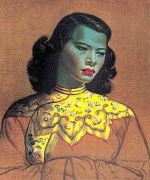Sixties
City presents
a wide-ranging series of
articles on all aspects of the Sixties, penned by the creator of the iconic
60s music paper Mersey
Beat
|
Sixties
City presents
a wide-ranging series of
articles on all aspects of the Sixties, penned by the creator of the iconic
60s music paper Mersey
Beat
|
||||||
|
 |
The Chinese Girl was originally painted by Tretchikoff in 1950, but was
first turned into an art print in 1960 and became the most famous art image
of the decade, displayed in millions of homes, particularly in Britain.
The first painting of the Chinese Girl, whose model was a member of the
local Chinese community, was destroyed when Tretchikoff’s South African
studio was burgled. He then met a restaurant owner’s daughter in San Francisco
and painted her wearing an exotic gown, topped by a gold colour. She has
jet black hair. She looks unsmiling, down and to her left and her hands
are folded out of sight. Although born in Russia, Tretchikoff spent most of his early life in the Far East before settling in South Africa in 1946. His parents fled the Russian revolution with their eight children, initially settling in the Chinese part of Manchuria. At the age of 16, on the money he made from painting executives of the Chinese-Eastern Railway, Tretchikoff moved to Shanghai. The self-taught artist was heavily panned by art critics and he was dubbed ‘the king of kitsch’, yet he became the most popular artist, next to Picasso, with the public. He started the painting of the Chinese Girl in Java in 1946 and finished it in 1950. Tretchikoff travelled the world promoting his paintings, which were said to have brought a touch of colour to the homes of ordinary people in the austere post-war years. His other works include Lady from the Orient; Miss Wong; Balinese Girl; Birth of Venus; Lenka and Dying Swan. Vladimir Griegorovitch Tretchikoff was born on 13th December 1913 in Petropavlovsk, Russia, now in Kazakhstan. When the Russian revolution began, his mother and father fled with their eight children to Manchuria. As a schoolboy, Tretchikoff began painting the scenery at the Harbin Opera House and decided to become an artist. In 1932, on the proceeds of painting sales, he moved to Shanghai where he became a cartoonist for the Shanghai Times.
|
|
Article
|